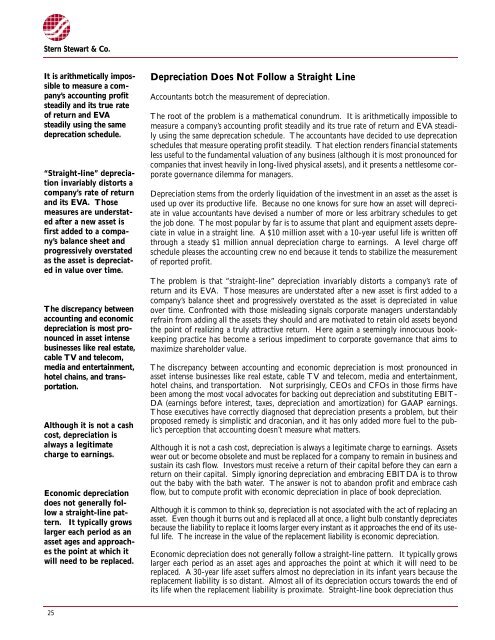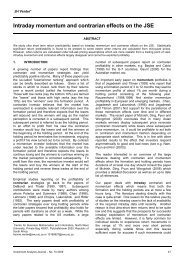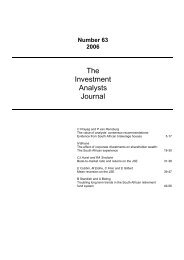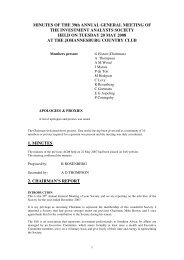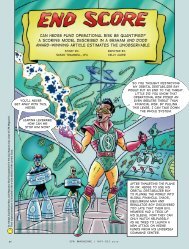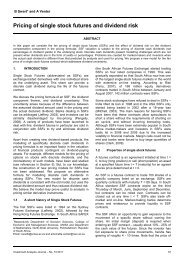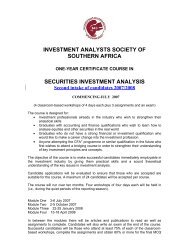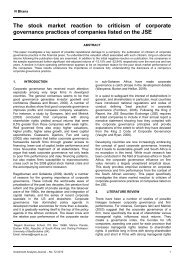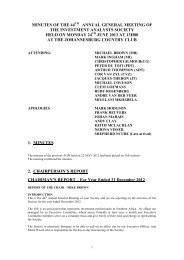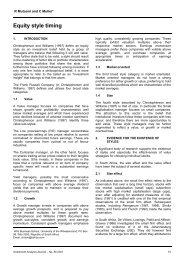Accounting is Broken - Investment Analysts Journal
Accounting is Broken - Investment Analysts Journal
Accounting is Broken - Investment Analysts Journal
Create successful ePaper yourself
Turn your PDF publications into a flip-book with our unique Google optimized e-Paper software.
Stern Stewart & Co.<br />
It <strong>is</strong> arithmetically impossible<br />
to measure a comp<br />
a n y ’s accounting pro f i t<br />
steadily and its true rate<br />
of re t u rn and EVA<br />
steadily using the same<br />
d e p recation schedule.<br />
“Straight-line” depre c i a-<br />
tion invariably d<strong>is</strong>torts a<br />
c o m p a n y ’s rate of re t u rn<br />
and its EVA. Those<br />
m e a s u res are understated<br />
after a new asset <strong>is</strong><br />
first added to a compan<br />
y ’s balance sheet and<br />
p ro g ressively overstated<br />
as the asset <strong>is</strong> depre c i a t-<br />
ed in value over time.<br />
The d<strong>is</strong>crepancy between<br />
accounting and economic<br />
d e p reciation <strong>is</strong> most pronounced<br />
in asset intense<br />
businesses like real estate,<br />
cable TV and telecom,<br />
media and entert a i n m e n t ,<br />
hotel chains, and transp<br />
o rtation.<br />
Although it <strong>is</strong> not a cash<br />
cost, depreciation <strong>is</strong><br />
always a legitimate<br />
c h a rge to earn i n g s .<br />
Economic depre c i a t i o n<br />
does not generally follow<br />
a straight-line patt<br />
e rn. It typically gro w s<br />
l a rger each period as an<br />
asset ages and appro a c h-<br />
es the point at which it<br />
will need to be re p l a c e d .<br />
D e p reciation Does Not Follow a Straight Line<br />
Accountants botch the measurement of depreciation.<br />
The root of the problem <strong>is</strong> a mathematical conundrum. It <strong>is</strong> arithmetically impossible to<br />
m e a s u re a company’s accounting profit steadily and its true rate of re t u rn and EVA steadily<br />
using the same deprecation schedule. The accountants have decided to use depre c a t i o n<br />
schedules that measure operating profit steadily. That election renders financial statements<br />
less useful to the fundamental valuation of any business (although it <strong>is</strong> most pronounced for<br />
companies that invest heavily in long-lived physical assets), and it presents a nettlesome corporate<br />
governance dilemma for managers.<br />
D e p reciation stems from the orderly liquidation of the investment in an asset as the asset <strong>is</strong><br />
used up over its productive life. Because no one knows for sure how an asset will depre c i-<br />
ate in value accountants have dev<strong>is</strong>ed a number of more or less arbitrary schedules to get<br />
the job done. The most popular by far <strong>is</strong> to assume that plant and equipment assets depreciate<br />
in value in a straight line. A $10 million asset with a 10-year useful life <strong>is</strong> written off<br />
t h rough a steady $1 million annual depreciation charge to earnings. A level charge off<br />
schedule pleases the accounting crew no end because it tends to stabilize the measure m e n t<br />
of re p o rted pro f i t .<br />
The problem <strong>is</strong> that “straight-line” depreciation invariably d<strong>is</strong>torts a company’s rate of<br />
re t u rn and its EVA. Those measures are understated after a new asset <strong>is</strong> first added to a<br />
c o m p a n y ’s balance sheet and pro g ressively overstated as the asset <strong>is</strong> depreciated in value<br />
over time. Confronted with those m<strong>is</strong>leading signals corporate managers understandably<br />
refrain from adding all the assets they should and are motivated to retain old assets beyond<br />
the point of realizing a truly attractive re t u rn. Here again a seemingly innocuous bookkeeping<br />
practice has become a serious impediment to corporate governance that aims to<br />
maximize shareholder value.<br />
The d<strong>is</strong>crepancy between accounting and economic depreciation <strong>is</strong> most pronounced in<br />
asset intense businesses like real estate, cable TV and telecom, media and entert a i n m e n t ,<br />
hotel chains, and transportation. Not surpr<strong>is</strong>ingly, CEOs and CFOs in those firms have<br />
been among the most vocal advocates for backing out depreciation and substituting EBIT-<br />
DA (earnings before interest, taxes, depreciation and amortization) for GAAP earn i n g s .<br />
Those executives have correctly diagnosed that depreciation presents a problem, but their<br />
p roposed remedy <strong>is</strong> simpl<strong>is</strong>tic and draconian, and it has only added more fuel to the publ<br />
i c ’s perception that accounting doesn’t measure what matters.<br />
Although it <strong>is</strong> not a cash cost, depreciation <strong>is</strong> always a legitimate charge to earnings. Assets<br />
wear out or become obsolete and must be replaced for a company to remain in business and<br />
sustain its cash flow. Investors must receive a re t u rn of their capital before they can earn a<br />
re t u rn on their capital. Simply ignoring depreciation and embracing EBITDA <strong>is</strong> to thro w<br />
out the baby with the bath water. The answer <strong>is</strong> not to abandon profit and embrace cash<br />
f l o w, but to compute profit with economic depreciation in place of book depreciation.<br />
Although it <strong>is</strong> common to think so, depreciation <strong>is</strong> not associated with the act of replacing an<br />
asset. Even though it burns out and <strong>is</strong> replaced all at once, a light bulb constantly depre c i a t e s<br />
because the liability to replace it looms larger every instant as it approaches the end of its useful<br />
life. The increase in the value of the replacement liability <strong>is</strong> economic depre c i a t i o n .<br />
Economic depreciation does not generally follow a straight-line pattern. It typically gro w s<br />
l a rger each period as an asset ages and approaches the point at which it will need to be<br />
replaced. A 30-year life asset suffers almost no depreciation in its infant years because the<br />
replacement liability <strong>is</strong> so d<strong>is</strong>tant. Almost all of its depreciation occurs towards the end of<br />
its life when the replacement liability <strong>is</strong> proximate. Straight-line book depreciation thus<br />
25


